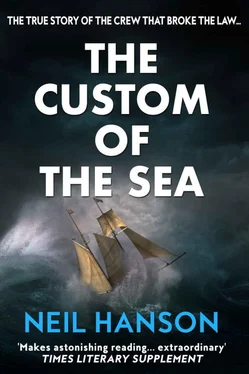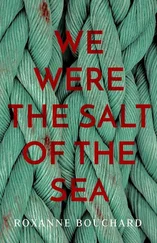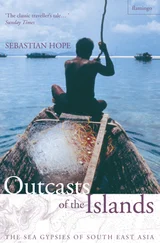It is natural to inquire how they could float such a vast distance upon the most frequented part of the Atlantic and not be discovered all this time. They were passed by more than a dozen sail, one of which came so nigh them that they could distinctly see the people on deck and on the rigging looking at them; but to the inexpressible disappointment of the starving and freezing men, they stifled the dictates of compassion, hoisted sail, and cruelly abandoned them to their fate.
Not all captains who refused to give aid in such circumstances were black-hearted. To rescue men from a dinghy or a derelict ship was a delicate and dangerous operation, particularly in merchant vessels that had few spare men, or often none. The sails had to be taken in and the vessel hove to, then a boat put overboard and the ship manoeuvred to leeward of the dinghy or wrecked ship. In heavy seas it could easily be further damaged or sunk during this operation and the undermanned rescuing vessel was also in peril. Many captains would only take the risk in flat, calm conditions.
The case of the Caledonia was also reported to the Select Committee on Shipwrecks of Timber Ships after twelve crew were stranded on the floating hulk when she foundered. Two men had their throats cut and the blood drained from them. The remainder were rescued by a Russian ship just in time to save the ship’s cabin boy from a similar end.
The Blake was another widely reported case. She sailed for Cork from Mississippi in 1856, but began to ship water almost at once. After being battered by a ferocious storm, she finally broached when the depth of water in the hold reached thirteen feet.
She was eventually righted, but in freezing temperatures, without water or food, the crew’s plight was desperate. On the seventh day the captain, Edward Rudolf, caught a half-drowned rat which, as he later told The Times , he ‘immediately cut up and shared out to each one; it was a delicious morsel’.
Three ships passed them without offering any assistance and on the thirteenth day they began to eat the body of a dead seaman. Four days later they were rescued by the Pigeon , which in turn ran out of water and was saved from similar dire straits only by the timely arrival of the Mercury . Eight of the Blake’s seventeen-man crew survived.
The crew of the George , yet another timber ship, fared even worse. On a voyage from Quebec to Greenock in 1822, a storm reduced the ship to a hulk. A woman, Joyce Rae, was the first to be sacrificed to feed the others and five sailors were also eaten before the survivors were rescued by the Salton , which in turn wrecked off the coast of Cumberland a month later. Only the captain and one seaman survived.
The double tragedy of the crew of the George and the unusual presence of a woman amongst the victims made it one of the best-known tales of the sea, commemorated in a score of ballads.
The Nottingham Galley was even more celebrated in its day, following the publication of rival and bitterly conflicting versions of events, from the ship’s captain, John Dean, and the mate, Christopher Langholm. According to the mate, Dean had overinsured the cargo and, after attempting to surrender the ship to privateers, had deliberately wrecked her. Dean attributed the wreck to a navigational error, but whatever the cause, the crew were stranded in the dead of winter on Boon Island, a barren rock three miles off the coast of Maine. They had nothing to eat but a little cheese from the ship’s stores that they found washed up among the rockweed, and such mussels and seaweed as they could find.
They salvaged some sodden planks and torn sails and used them to build a crude triangular tent just large enough for them to huddle inside. Many became crippled with frostbite, the rest worked to assemble first a boat and then a raft from the timbers of the wreck, but both were swamped by the swell and two men drowned.
When the ship’s carpenter died after about twenty days,
after abundance of mature thought and consultation about the lawfulness or sinfulness on the one hand and absolute necessity on the other, judgment, conscience, etc, were obliged to submit to the more prevailing argument of our craving appetites, so that at last we determined to satisfy our hunger and support our feeble bodies with the carcass.
Dean ordered ‘his skin, head, hands, feet and bowels to be buried in the sea and the body to be quartered for conveniency of carriage’.
He complained about the ‘utmost greediness’, with which his crew attacked the body and the way it transformed their behaviour.
Their very natural dispositions changed, and that affectionate, peaceable temper they had all along discovered totally lost, their eyes staring and looking wild, their countenances fierce and barbarous, and instead of obeying my commands as they had universally and readily done before, I found all I could say, even prayers and entreaties, vain and fruitless, nothing now to be heard but brutish quarrels, with horrid oaths and imprecations, instead of that quiet, submissive spirit of prayer and supplication we had before enjoyed.
The ten survivors were rescued before any further men fell victim to their crewmates’ greediness, and the mate’s allegations of overinsurance and deliberate wrecking remained unproven.
The Francis Spaight , another timber ship, which carried Irish emigrants to North America on the return voyage — pure profit, since the ship would otherwise have had to sail west in ballast — broached in December 1837 while carrying a load of timber. Three seamen were washed overboard and drowned.
Fifteen men now remained on board, clinging to the rigging and the hull. Once the captain had persuaded the crew to cut away the masts and rigging, the ship righted itself but it was waterlogged, wallowing with only its poop and bulwarks above the surface.
In the course of the next week two ships were seen but passed without responding to their desperate pleas. On the sixteenth day after the accident, ‘There was now such a length of time without substance that it was beyond human nature to endure it any longer.’
The captain’s opinion was that, ‘One should suffer for the rest and that lots should be drawn between the four boys, the apprentices, as they had no families and could not be considered so great a loss to their friends as they that had wives and children depending on them.’
All merchant ships at the time were required by law to carry a proportion of apprentices. The aim was to ensure a pool of trained seamen for merchantmen and for the Royal Navy in time of war, but the apprentice boys were often disregarded and disliked by the regular crew and subject to widespread physical and sexual abuse. If the ship was wrecked, their position was even more vulnerable.
The apprentices agreed to the casting of lots, but not that it should be restricted to them alone. The crew forced them to comply. One apprentice, Patrick O’Brien, was particularly unpopular. He was blindfolded and pushed to his knees, and as a sailor drew out each of the four lots, O’Brien was forced to name the recipient. He called the first lot for ‘Little Johnny Sheehan’. It was put aside without comment. When the next lot was drawn he said it was to fall on himself. He was then told that he had drawn the fatal lot.
The cook at first refused to bleed O’Brien to death but the crew threatened to kill him in his place if he did not do so. Several botched attempts were made before O’Brien’s throat was finally cut. Two days later the cook, who had drunk sea-water, began to go mad. His throat was cut and his blood was drunk. Two more days elapsed and then another of the apprentices, George Burns, was also bled to death. Another, Michael Behane, only escaped the same fate by dying of natural causes first.
Читать дальше











